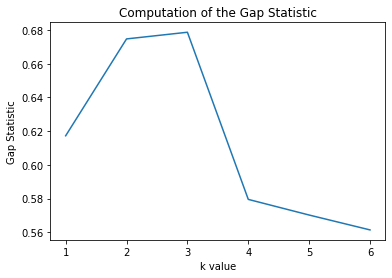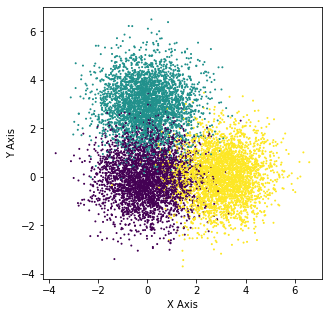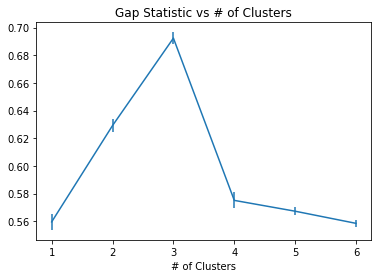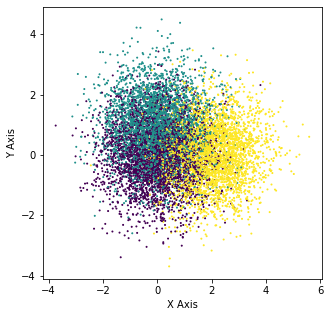Cool Tool: Elbow Plot and Gap Statistic
Optimal Cluster Selection
Introduction: Elbow Plot
One of the problems in unsupervised clustering is choosing the number of clusters that we are looking for. Specifically when we are using k-means, we need to specify our value of k. One of the most popular methods to choose k is the elbow method. In this approach, we track a quantity called inertia. The whole idea of k-means is to minimize this value that we call inertia which is also referred to as within-cluster sum of squares criterion. Check out the clustering page at sklearn to learn more.
\[\sum\limits_{i=0}^n \min\limits_{\mu_j \in C}(||x_i-\mu_j||^2)\]As we increase our value of k, invariably our inertia goes down. We then look for a value of k where there is a large drop in inertia going from k-1 to k, then a relatively small drop in inertia going from k to k+1. This just indicates that our value of k was really good for decreasing inertia and increasing past this point would be not as useful.
Let’s try to see how well this method to “guess” the proper amount of clusters are needed:
import numpy as np
import matplotlib.pyplot as plt
from sklearn.datasets import make_blobs
from sklearn.cluster import KMeans
import pandas as pd
from sklearn.metrics import pairwise_distances
X_1, y_1 = make_blobs(n_samples=10000, centers=[[0,0]], n_features=2,random_state=0)
plt.scatter(X_1[:,0],X_1[:,1],s=1)
<matplotlib.collections.PathCollection at 0x261cd66c808>

With the code snippet above, we see that we can create gaussian blobs of points in 2D. We are going to consider these as clusters and we are going to create a dataset where we have two blobs that are somewhat separated from each other.
distance=4
X_2, y_2 = make_blobs(n_samples=3000, centers=[[0,0],[0,distance]], n_features=2,random_state=0)
plt.figure(figsize=(5,5))
plt.scatter(X_2[:,0],X_2[:,1],c=y_2,s=1)
plt.xlabel("X Axis")
plt.ylabel("Y Axis")
Text(0, 0.5, 'Y Axis')

Here we can clearly see that there are two different clusters present. Now if we are to train a bunch of k-means classifiers on this dataset and look at the overall elbow diagram, we should expect to see that the optimal value for k would be 2.
def training_classifiers(max_number_clusters,train_data):
"""
This function returns a list of k-means classifiers trained on the input train data where k is set to [1,...,max_number_clusters]
Parameters
----------
max_number_clusters: int
train_data: np.array(), shape of array (sampling dimension, data dimension)
Returns
-------
[kMeans()], kMeans classifiers in an array
"""
k_means_algos_down = []
ks = list(range(1,max_number_clusters+1))
for k in ks:
# print(k)
kmeans = KMeans(init='k-means++',n_clusters = k,n_init=10,verbose=3,n_jobs=-1)
kmeans.fit(train_data)
k_means_algos_down.append(kmeans)
return k_means_algos_down
b = training_classifiers(5,X_2)
inertias = [algo.inertia_ for algo in b]
plt.plot(list(range(1,6)),inertias)
plt.xlabel("Value for k")
plt.ylabel("Inertia")
plt.title("Elbow Diagram")
Text(0.5, 1.0, 'Elbow Diagram')

Above we can clearly see that there is a “kink” at the value of 2 so according the Elbow Diagram the optimal value for k is 2.
What would be an interesting study would be varying the distance between our two blobs in order to see when exactly does this kink form and how does it form.
distance_between_blobs = np.linspace(0,3,10) # Let's set a series of varying distances
elbows = []
for distance in distance_between_blobs:
X_temp, y = make_blobs(n_samples=3000, centers=[[0,0],[0,distance]], n_features=2,random_state=0)
a = training_classifiers(5,X_temp)
inertias = [algo.inertia_ for algo in a]
elbows.append(inertias)
fig, axs = plt.subplots(2,5, figsize=(15, 6), facecolor='w', edgecolor='k')
fig.subplots_adjust(hspace = .5, wspace=.5)
axs = axs.ravel()
for i in range(10):
axs[i].plot(list(range(1,6)),elbows[i])
axs[i].set_title("DBB: %.2f" % (distance_between_blobs[i]))
axs[i].set_xlabel("k value")

We see that around 1.67 DBB (Distance Between Blobs) we begin to really see the kink form. The distribution at his point looks like the following:
distance = 1.67
X_3, y_3 = make_blobs(n_samples=3000, centers=[[0,0],[0,distance]], n_features=2,random_state=0)
plt.figure(figsize=(5,5))
plt.scatter(X_3[:,0],X_3[:,1],c=y_3,s=1)
plt.xlabel("X Axis")
plt.ylabel("Y Axis")
Text(0, 0.5, 'Y Axis')

Crazy right because at this point it is pretty hard to tell with the human eye.
Gap Statistic
Now we are going to consider a different way to tell how many clusters there are and that is the Gap Statistic Paper Reference.
Some inspiration:
- https://datasciencelab.wordpress.com/tag/gap-statistic/
- https://datasciencelab.wordpress.com/2013/12/12/clustering-with-k-means-in-python/
- https://datasciencelab.wordpress.com/2013/12/12/clustering-with-k-means-in-python/
The Gap Statistic is defined in the following way:
\[W_k = \sum\limits^k_{r=1}\frac{1}{n_r}D_r\]We first need to define the pooled within-cluster sum of squares around the cluster means
Arbitrary Data Creation
# import seaborn as sns; sns.set()
##Visualization with Seaborn if required
# X1_dataframe = pd.DataFrame(X[y==0],columns=["x","y"])
# X2_dataframe = pd.DataFrame(X[y==1],columns=["x","y"])
# X3_dataframe = pd.DataFrame(X[y==2],columns=["x","y"])
# fig, ax = plt.subplots()
# ax.axis('equal')
# ax = sns.kdeplot(X1_dataframe.x,X1_dataframe.y, cmap="Reds", shade=True, shade_lowest=False, ax=ax)
# ax = sns.kdeplot(X2_dataframe.x,X2_dataframe.y, cmap="Blues", shade=True, shade_lowest=False, ax=ax)
# ax = sns.kdeplot(X3_dataframe.x,X3_dataframe.y, cmap="Greens", shade=True, shade_lowest=False, ax=ax)
X_4, y_4 = make_blobs(n_samples=10000, centers=[[0,0],[0,2],[3,0]], n_features=2,random_state=0)
plt.figure(figsize=(5,5))
plt.scatter(X_4[:,0],X_4[:,1],c=y_4,s=1)
plt.xlabel("X Axis")
plt.ylabel("Y Axis")
Text(0, 0.5, 'Y Axis')

Designing \(W_k\)
\[W_k = \sum\limits^k_{r=1}\frac{1}{n_r}D_r\]Our first quantity is referred to as the pooled within-cluster sum of squares which is really just the sum of all the pairwise distances within a cluster divided by the size of the cluster.
def W_k(clusters):
"""
Calculates W_k according to the formula above
Parameters
----------
clusters: np.array(), shape of array (index of cluster, cluster_data)
Returns
-------
W_k: float
"""
total=0
for i in range(len(clusters)):
D = pairwise_distances(clusters[i])
total += np.sum(D)/(2*len(clusters[i]))
return total
# Training the models
k_means_algos_down = []
ks = list(range(1,7))
for k in ks:
print(k)
kmeans = KMeans(init='k-means++',n_clusters = k,n_init=10,verbose=3,n_jobs=-1,random_state=0)
kmeans.fit(X_4)
k_means_algos_down.append(kmeans)
1
2
3
4
5
6
k=3
means = k_means_algos_down[2].cluster_centers_
clusters = np.array([X_4[k_means_algos_down[2].labels_==i] for i in range(k)])
W_ks = []
for j in range(6):
clusters = np.array([X_4[k_means_algos_down[j].labels_==i] for i in range(j+1)])
W_ks.append(W_k(clusters))
plt.figure();plt.title("Internal Sum of Squares vs k")
plt.plot(list(range(1,7)),W_ks)
plt.xlabel("k value")
plt.ylabel("Internal Sum of Squares")
Text(0, 0.5, 'Internal Sum of Squares')

We can visualize this in a similar way to the elbow plot to observe a similar drop off with increasing k. As with inertia, we see that the Internal Sum of Squares decreases monotonically with increasing k.
Generating a Uniform Sample
The second step of the process of calculating the Gap Statistic is having a baseline or a uniformly random sample to compare the Internal Sum of Square with. Therefore we attempt to generate a uniform distribution over the “bounding dimensions” (maximum and minimum values over each dimension).
def bounding_dimensions(X):
"""
Parameters
----------
X: np.array(), training data of arbitrary shape
Returns
-------
dimension_ranges: np.array(), array where each dimension contains the max and min values for that dimension from X
"""
dimension_ranges = []
for i in range(X.shape[1]):
dimension_ranges.append([min(X[:,i]),max(X[:,i])])
return np.array(dimension_ranges)
def generating_uniform_over_variables(ranges,size=1000):
"""
Parameters
----------
ranges: np.array(), max and min values for each dimension considered
size: int, random values sampled
Returns
-------
output: np.array(), uniformly sampled data from the max and min values for each dimension
"""
return np.array([np.random.uniform(low=r[0],high=r[1],size=size) for r in ranges]).T
With these functions we can calculating the bounding dimensions and a uniform sample over the bounding dimensions from our original data X.
dimensions = bounding_dimensions(X_4)
uniform_sample = generating_uniform_over_variables(dimensions,size=10000)
plt.scatter(uniform_sample[:,0],uniform_sample[:,1],s=1)
<matplotlib.collections.PathCollection at 0x261cdb17f88>

# Training the models
uniform_k_means_algos_down = []
ks = list(range(1,7))
for k in ks:
print(k)
kmeans = KMeans(init='k-means++',n_clusters = k,n_init=10,verbose=3,n_jobs=-1)
kmeans.fit(uniform_sample)
uniform_k_means_algos_down.append(kmeans)
1
2
3
4
5
6
W_ks_star = []
for j in range(6):
clusters = np.array([uniform_sample[uniform_k_means_algos_down[j].labels_==i] for i in range(j+1)])
W_ks_star.append(W_k(clusters))
plt.figure();plt.title("Internal Sum of Squares vs k")
plt.plot(list(range(1,7)),W_ks_star)
plt.xlabel("k value")
plt.ylabel("Internal Sum of Squares")
Text(0, 0.5, 'Internal Sum of Squares')

Overall Procedure for the Gap Statistic
Now the overall procedure of calculating the gap statistic is the following:
- Cluster the observed data, varying the total number of clusters from \(k=1,2,\dots,K\) giving within-dispersion measures \(W_k,k=1,2,\dots,K\).
- Generate B reference sets, using the uniform prescription (a) or (b) above, and cluster each one giving within-dispersion measures \(W^*_{kb}\), \(b=1,2,\dots,B\), \(k=1,2,\dots,K\) then we compute the estimated gap statistic \(\text{Gap}(k)=(1/B)\sum\limits_{b}\log(W^{*}_{kb})-\log(W_k)\)
- Then we are going to have to have to have \(\bar{l} = (1/B)\sum_{b}\log(W^*_{kb})\), computing the standard deviation gives us: \(sd_k = [(1/B)\sum_b[\log(W^*_{kb})-\bar{l}]^2]^{1/2}\) then we need to define \(s_k = sd_k \sqrt{1+1/B}\). Then we choose the number of clusters via: \(\hat{k} = \text{smallest k such that Gap(k)}\geq \text{Gap(k+1)}-s_{k+1}\)
The final step is really needed to establish when the distance between two values is great enough to consider it a drop
Therefore with the previous two steps, we can compute the Gap Statistic of the data X
plt.figure();plt.title("Computation of the Gap Statistic")
plt.plot(list(range(1,7)),np.log(W_ks_star)-np.log(W_ks))
plt.ylabel("Gap Statistic")
plt.xlabel("k value")
Text(0.5, 0, 'k value')

And we see that we reach a value of k=3 as our peak (without considering the standard deviation calculation) and therefore k=3 is optimal in this case.
def creating_classifiers(max_number_clusters,train_data,random_state=0):
k_means_algos = []
ks = list(range(1,max_number_clusters+1))
for k in ks:
print(k)
kmeans = KMeans(init='k-means++',n_clusters = k,n_init=10,verbose=3,n_jobs=-1,random_state=random_state)
kmeans.fit(train_data)
k_means_algos.append(kmeans)
return k_means_algos
def W_k(clusters):
total=0
for i in range(len(clusters)):
D = pairwise_distances(clusters[i])
total += np.sum(D)/(2*len(clusters[i]))
return total
def calculation_of_W_ks(max_number_clusters,X):
output = []
classifiers = creating_classifiers(max_number_clusters,X)
for i in range(max_number_clusters-1):
clusters = np.array([X[classifiers[i].labels_==j] for j in range(i+1)])
output.append(W_k(clusters))
return np.array(output)
def bounding_dimensions(X):
dimension_ranges = []
for i in range(X.shape[1]):
dimension_ranges.append([min(X[:,i]),max(X[:,i])])
return np.array(dimension_ranges)
def generating_uniform_over_variables(ranges,size=1000):
return np.array([np.random.uniform(low=r[0],high=r[1],size=size) for r in ranges]).T
#####################################################################################################################
# We introduce this collection of functions to aid in the calculation of the Gap Statistic #
#####################################################################################################################
def calculation_of_W_ks_star(max_number_clusters,X,random_state=0):
"""
Parameters
----------
max_number_clusters: int
X: np.array(), shape of array (sampling dimension, data dimension)
random_state: int, used to fix the output
Returns
-------
output: np.array(), W_ks calculated as described for the Gap Statistic
"""
output = []
dimension_ranges = bounding_dimensions(X)
uniform_sample = generating_uniform_over_variables(dimension_ranges,size=len(X))
classifiers = creating_classifiers(max_number_clusters,uniform_sample,random_state=random_state)
for i in range(max_number_clusters-1):
clusters = np.array([uniform_sample[classifiers[i].labels_==j] for j in range(i+1)])
output.append(W_k(clusters))
return np.array(output)
def calculation_of_log_W_ks_star_B(max_number_clusters,X,B):
"""
Parameters
----------
max_number_clusters: int
X: np.array(), shape of array (sampling dimension, data dimension)
B: int, number of simulations for the reference data sets (the more used the lower the standard deviation)
Returns
-------
output: np.array(), W_ks_star_B calculated as described for the Gap Statistic
"""
B_simulations = np.array([np.log(calculation_of_W_ks_star(max_number_clusters,X,random_state=i)) for i in range(B)])
B_means = np.mean(B_simulations,axis=0)
return B_means
def calculation_of_log_W_ks(max_number_clusters,X):
"""
Parameters
----------
max_number_clusters: int
X: np.array(), shape of array (sampling dimension, data dimension)
Returns
-------
output: np.array(), log_W_ks calculated as described for the Gap Statistic
"""
return np.log(calculation_of_W_ks(max_number_clusters,X))
def calculation_of_log_W_ks_star_B_A(max_number_clusters,X,B):
"""
Parameters
----------
max_number_clusters: int
X: np.array(), shape of array (sampling dimension, data dimension)
B: int, number of simulations for the reference data sets (the more used the lower the standard deviation)
Returns
-------
output: (np.array(),np.array()), mean of log_W_ks_star_B calculated as described for the Gap Statistic, then the standard deviation of log from its average
"""
B_simulations = np.array([np.log(calculation_of_W_ks_star(max_number_clusters,X,random_state=i)) for i in range(B)])
B_means = np.mean(B_simulations,axis=0)
#Calculating Standard Deviation
sd_k = np.power(np.mean([np.power((B_simulations[i]-B_means),2) for i in range(B)],axis=0),0.5)
s_k = sd_k*np.power(1+1/B,0.5)
return B_means,s_k
To test our general functions we consider the following series of tests over X
calc = calculation_of_W_ks(7,X_4)
calc_star = calculation_of_W_ks_star(7,X_4,random_state=0)
1
2
3
4
5
6
7
1
2
3
4
5
6
7
plt.figure();plt.title("Computation of the Gap Statistic")
plt.plot(list(range(1,7)),np.log(calc_star)-np.log(calc))
plt.ylabel("Gap Statistic")
plt.xlabel("k value")
Text(0.5, 0, 'k value')

We see that the shape is roughly the same!
In my opinion, the Gap Statistic is really a method that compares a given datasets ability to be clustered versus a uniform example of the data with the same range. When we see that it is very clusterable, then suddenly not very clusterable, then we choose that previous value of k as the optimal value.
Testing Validity
Let’s see how this metric performs under a variety of different datasets!
Three Obvious Blobs
X_5, y_5 = make_blobs(n_samples=10000, centers=[[0,0],[0,3],[3,0]], n_features=2,random_state=0)
plt.figure(figsize=(5,5))
plt.scatter(X_5[:,0],X_5[:,1],c=y_5,s=1)
plt.xlabel("X Axis")
plt.ylabel("Y Axis")
Text(0, 0.5, 'Y Axis')

calc = calculation_of_log_W_ks(7,X_5)
1
2
3
4
5
6
7
calc_star, s_k = calculation_of_log_W_ks_star_B_A(7,X_5,5)
1
2
3
4
5
6
7
1
2
3
4
5
6
7
1
2
3
4
5
6
7
1
2
3
4
5
6
7
1
2
3
4
5
6
7
plt.errorbar(range(1,7),calc_star-calc,yerr=s_k)
plt.title("Gap Statistic vs # of Clusters")
plt.xlabel("Gap Statistic")
plt.xlabel("# of Clusters")
Text(0.5, 0, '# of Clusters')

We see that for this example, the gap statistic indicates that it is very clearly 3 clusters in this dataset.
Three Less Obvious Blobs
X_6, y_6 = make_blobs(n_samples=10000, centers=[[0,0],[0,1],[2,0]], n_features=2,random_state=0)
plt.figure(figsize=(5,5))
plt.scatter(X_6[:,0],X_6[:,1],c=y_6,s=1)
plt.xlabel("X Axis")
plt.ylabel("Y Axis")
Text(0, 0.5, 'Y Axis')

calc = calculation_of_log_W_ks(7,X_6)
1
2
3
4
5
6
7
calc_star, s_k = calculation_of_log_W_ks_star_B_A(7,X_6,5)
1
2
3
4
5
6
7
1
2
3
4
5
6
7
1
2
3
4
5
6
7
1
2
3
4
5
6
7
1
2
3
4
5
6
7
plt.errorbar(range(1,7),calc_star-calc,yerr=s_k)
plt.title("Gap Statistic vs # of Clusters")
plt.xlabel("Gap Statistic")
plt.xlabel("# of Clusters")
Text(0.5, 0, '# of Clusters')

We see that for this example, the gap statistic is more ambigious in determining the optimal number of clusters in this dataset since the dataset isn’t as clearly separated into three groups.
Summary
Here we were able to discuss methods to select the optimal number of clusters for unsupervised clustering with k-Means. We covered:
- Elbow Method
- Gap Statistic
Other methods that are not covered include:
- Gaussian Mixture Model (AIC and BIC)
- Silhoutte Method
- Calinski Criterion
These techniques are usually employed in data exploration when trying to understand the structure of the data that is being delt with! I used this for a project for unsupervised clustering where the whole idea was to understand the data and these techinques were really insightful!